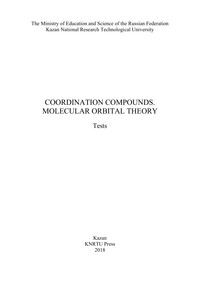Coordination compounds. Molecular orbital theory : tests = Комплексные соединения. Теория молекулярных орбиталей : тесты
Покупка
Тематика:
Химические элементы и их соединения
Год издания: 2018
Кол-во страниц: 44
Дополнительно
Вид издания:
Учебно-методическая литература
Уровень образования:
ВО - Бакалавриат
Артикул: 787071.01.99
The study guide contains individual test tasks, which can be used to control student achievements in the topic "Coordination compounds. Molecular orbital theory".
The tasks are developed for the first-year students of engineering degree programs, who study the discipline "General and Inorganic Chemistry" and "The additional chapters of Inorganic Chemistry" in English.
The study guide was prepared at the Department of Inorganic Chemistry.
Тематика:
ББК:
УДК:
ОКСО:
- ВО - Бакалавриат
- 18.03.01: Химическая технология
- ВО - Магистратура
- 18.04.01: Химическая технология
ГРНТИ:
Скопировать запись
Фрагмент текстового слоя документа размещен для индексирующих роботов
The Ministry of Education and Science of the Russian Federation Kazan National Research Technological University
COORDINATION COMPOUNDS. MOLECULAR ORBITAL THEORY
Tests
Kazan
KNRTU Press
2018
UDC 546; 54-386
The study guide is published in accordance with the decision of the Faculty of Chemical Technologies
Reviewers:
Ph. D. (in chemistry), Full Prof. N. B. Berezin
Ph. D. (in chemistry), Full Prof. M. B. Gazizov
Contributors:
Assoc. Prof. М. М. Petrova Full Prof. Е. М. Zueva Full Prof. А. М. Kuznetsov
Coordination compounds. Molecular orbital theory : tests / contributors : M. M. Petrova, E. M. Zueva, A. M. Kuznetsov; The Ministry of Education and Science of the Russian Federation, Kazan National Research Technological University. - Kazan: KNRTU Press, 2018. - 44 p.
The study guide contains individual test tasks, which can be used to control student achievements in the topic "Coordination compounds. Molecular orbital theory".
The tasks are developed for the first-year students of engineering degree programs, who study the discipline "General and Inorganic Chemistry" and "The additional chapters of Inorganic Chemistry" in English.
The study guide was prepared at the Department of Inorganic Chemistry.
UDC 546; 54-386
2
INDIVIDUAL TASKS
Variant 1
Task 1. Determine the electronic structure of the octahedral [Co(NH3)6]²⁺ complex within the framework of the molecular orbital (MO) theory.
1. The number of valence electrons in this complex is
А) 18
B) 19
C) 20
D) 21
2. Draw the MO-diagram of this complex (without accounting for the п-bonding effect) and distribute valence electrons into atomic and molecular orbitals in accordance with the available A and P values (see Appendix). Specify the ground-state valence electron configuration of this complex.
А) -.<■:•■* C) OsVodVdV?
B) QsVodVdVd³ D) QsVod4n%*d⁴
3. Linear combinations of which two orbitals (metal-based and ligand
*
based ones) form the <7X - and ax -MOs?
А)
B)
C)
D)
4. How many electrons occupy bonding, antibonding, and non-bonding MOs in this complex?
А) 12; 2; 5 C) 5; 2; 12
B) 12; 5; 2 D) 5; 12; 2
3
5. Specify whether this complex is a high-spin or a low-spin one, paramagnetic or diamagnetic.
А) paramagnetic C) high-spin
B) diamagnetic D) low-spin
Task 2. The electronic transition in a complex corresponds to the light absorption at 495 nm. What color is the complex (see Appendix)?
А) green C) colorless
B) blue-green D) red
Variant 2
Task 1. Determine the electronic structure of the octahedral [FeF6]³ complex within the framework of the molecular orbital (MO) theory.
1. The number of valence electrons in this complex is
А) 16 C) 18
B) 17 D) 19
2. Draw the MO-diagram of this complex (without accounting for the п-bonding effect) and distribute valence electrons into atomic and molecular orbitals in accordance with the available A and P values (see Appendix). Specify the ground-state valence electron configuration of this complex.
2—6—4 —°5
C⁾ asapad^J
D)
2—6—4 — °4—*1 A⁾ °а°Л Od
2—6 — 4 —°2-*3
B⁾ ОО°~, Od
—2—6—4 — °3— *2
О О О ^TZj О л s pdd d
4
B)
D)
4. How many electrons occupy bonding, antibonding, and non-bonding MOs in this complex?
А) 12; 2; 3 C) 12; 5; 2
B) 12; 3; 2 D) 12; 3; 1
5. Specify whether this complex is a high-spin or a low-spin one, paramagnetic or diamagnetic.
А) paramagnetic C) high-spin
B) diamagnetic D) low-spin
Task 2. The electronic transition in a complex corresponds to the light absorption at 654 nm. What color is the complex (see Appendix)?
А) green C) colourless
B) blue-green D) red
Variant 3
Task 1. Determine the electronic structure of the octahedral [Co(CN)6]³ complex within the framework of the molecular orbital (MO) theory.
1. The number of valence electrons in this complex is
А) 16 C) 18
B) 17 D) 19
2. Draw the MO-diagram of this complex (without accounting for the п-bonding effect) and distribute valence electrons into atomic and molecular orbitals in accordance with the available A and P values (see Appendix). Specify the ground-state valence electron configuration of this
complex.
А) ^»j^:⁴^:²
b) tXt»*³
C)
D)
2 6 4 ^об
Ts Оp^d^d
_2 б 4 o5 *1
О О О,, i О л
s pdd d
5


